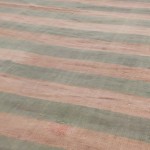Antique Cotton Dhurrie Rug
The weaving of flat-woven cotton carpets known as dhurries is cited in Mughal chronicles of the 15th century. Probably one of the earliest forms of floor covering, dhurries were woven in various formats according to their function, which range from bed covers to prayer mats. Most were produced in the northern region of Rajasthan, almost always in the local jails. These were often commissioned for specific areas of the Maharaja’s palaces and are often of massive dimensions.
Here we have a striped pattern composed of two colours which balance each other perfectly. Celadon green alternated to a striated tonality of soft terracotta containing touches of taupe is a truly magical combination, creating a carpet that will surely complement its interior in the best possible way,





